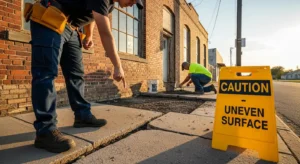Slip and fall accidents happen when someone loses their balance because of unsafe conditions and gets hurt. Common reasons for these accidents include wet floors, uneven surfaces, poor lighting, loose carpets, or obstacles in walkways. You often see these incidents in places like grocery stores, apartment complexes, parking lots, and private homes.
Comparative negligence is an important concept in personal injury law, especially for slip and fall cases. It deals with situations where both the property owner and the injured person might share some responsibility for the accident. For instance, if you slip on a spill that had a warning sign but chose to ignore it, your own actions could come into play.
Understanding comparative negligence is vital for both injured individuals and property owners. If you get injured in a slip and fall case and are found partially at fault, your compensation may be reduced. Property owners use these rules to defend against claims or limit payouts.
Sharing fault directly affects compensation. If a court decides that both parties were involved in causing the accident, it assigns each one a percentage of responsibility. Your damages are then adjusted based on this division, so knowing how comparative negligence works can greatly impact what you receive after a slip and fall injury.
What Is Comparative Negligence?
Comparative negligence is a legal principle used to determine how much blame each party involved in an accident, like a slip and fall, is responsible for. This concept becomes important when both the injured person and the property owner share some degree of fault. By figuring out the percentages of blame, comparative negligence directly impacts the amount of compensation one can receive.
Comparative Negligence Definition
In simple terms, comparative negligence assigns liability based on how much each party’s actions contributed to the incident. Instead of putting all the blame on one side, this system acknowledges that accidents often involve shared responsibility. For example, if a customer slips on a wet floor but was not paying attention because they were texting, they might be found partially responsible.
Pure vs. Modified Comparative Negligence Systems
States use two main approaches:
- Pure Comparative Negligence:
- You can recover damages even if you are mostly at fault (up to 99%). Your compensation will be reduced by your percentage of blame. For instance, if the total damages are $10,000 and you’re found 60% responsible, you would collect $4,000.
- Modified Comparative Negligence:
- You can only recover damages if your share of fault is below a certain limit—typically 50% or 51%. If your responsibility equals or exceeds that limit, you cannot collect any damages. For example, if an injured person is found 55% at fault in a state with a 51% rule, they would receive nothing.
How Fault Percentages Affect Damage Recovery
Your percentage of fault will directly reduce the amount of damages you can recover. If multiple parties contributed to the dangerous situation—such as a landlord failing to fix broken stairs and a tenant not turning on available lights—the court will look at each action and assign fault accordingly.
State Variations in Shared Fault Rules
Not all states handle comparative negligence in the same way:
- Some states use pure systems (e.g., California, New York).
- Other states follow modified rules with either a 50% or 51% cutoff (e.g., Texas uses a 51% rule; Georgia uses 50%).
Understanding these differences can help clarify your rights and risks when pursuing or defending against slip and fall claims involving shared legal responsibility.
Duty of Care in Slip and Fall Cases
 Property owners have a legal responsibility known as the duty of care. This duty requires them to take reasonable steps to keep their premises safe for anyone who enters, whether that person is a customer, tenant, or guest. If they fail to fulfill this responsibility, it can lead to premises liability, which holds owners legally accountable for injuries that occur on their property.
Property owners have a legal responsibility known as the duty of care. This duty requires them to take reasonable steps to keep their premises safe for anyone who enters, whether that person is a customer, tenant, or guest. If they fail to fulfill this responsibility, it can lead to premises liability, which holds owners legally accountable for injuries that occur on their property.
Key responsibilities of property owners include:
- Regularly inspecting the property for potential hazards
- Promptly repairing unsafe conditions once discovered
- Providing adequate warnings (such as signs or barricades) when immediate repair isn’t possible
Common hazardous conditions frequently trigger slip and fall incidents. These are not always dramatic; often, they’re everyday oversights:
- Wet floors: Spills in grocery aisles, leaks near refrigeration units, or recently mopped entryways without warning signs can all create slippery surfaces.
- Uneven surfaces: Cracked sidewalks, loose tiles, torn carpets, or abrupt changes in floor height increase the risk of tripping.
- Poor lighting: Dim hallways, stairwells without functioning lights, or parking lots with limited visibility make it difficult for visitors to spot dangers.
A property owner’s failure to address any of these issues may result in liability if someone gets hurt. The extent of that responsibility—and whether the injured party shares some blame—depends on how the duty of care was managed and if reasonable precautions were taken.
The way courts evaluate these details directly relates to comparative negligence analysis in slip and fall claims.
How Comparative Negligence Applies in Slip and Fall Claims
In slip and fall claims, the concept of comparative negligence becomes central when both the property owner and the injured party contribute to the accident. Courts examine each party’s actions leading up to the incident, assigning a percentage of fault that directly impacts injury compensation reduction.
Common Scenarios of Shared Fault
Ignoring Warning Signs: If a business places a clear “wet floor” sign and a customer walks through the area anyway, their decision may be seen as careless.
Inappropriate Footwear: Wearing shoes with poor traction on a snowy walkway can shift some responsibility to the injured person.
Distracted Behavior: Texting or not watching where you’re going—such as looking at your phone—may result in shared fault if these actions contributed to the fall.
How Defendants Use Comparative Negligence as a Defense
Property owners and their insurers often invoke comparative negligence as a shared fault defense. Their legal teams seek evidence showing that:
- The hazard was obvious and should have been avoided.
- The injured person was acting recklessly or disregarded safety warnings.
- The plaintiff’s own negligence played a significant role in causing the accident.
When successful, this defense can reduce or even eliminate financial liability. For example, if you are found 30% responsible for your injuries, your compensation is reduced by that same percentage. In some states with modified comparative negligence rules, being more than 50% at fault may bar recovery altogether.
Understanding comparative negligence in slip and fall cases means recognizing these nuances. Every detail matters—how you moved, what you saw, and how both sides acted before the accident occurred. This framework shapes how much compensation is possible after a slip and fall claim.
The Role of Evidence in Establishing Fault and Liability in Slip and Fall Cases with Comparative Negligence Claims
Accident evidence is crucial in any slip and fall case, especially when comparative negligence is involved. When both the injured person and the property owner may be partially responsible, thorough documentation can make the difference between a successful claim and a rejected one.
1. Photographs
 Taking clear photographs of the accident scene right after it happens is extremely important. These pictures should capture:
Taking clear photographs of the accident scene right after it happens is extremely important. These pictures should capture:
- The hazard itself—like a wet floor, broken step, or poor lighting
- The surrounding area to show if there were any warning signs or barriers
- Any visible injuries you sustained
Photographic evidence can challenge claims that hazards were obvious or properly marked, supporting your version of events. Property owners can also benefit from taking photos to demonstrate regular maintenance or posted warnings.
2. Witness Testimony
Statements from witnesses can help confirm how the accident happened and who was responsible for it. Eyewitnesses may:
- Describe whether warning signs were present or absent
- Confirm if you seemed distracted or were being careful
- Provide an unbiased account of conditions at the time
Written statements from employees, bystanders, or other customers carry significant weight when memories fade or stories conflict. Consistent testimony can validate photographic evidence and give a more complete picture of fault distribution.
Both accident evidence and witness testimony provide concrete support for your side in comparative negligence disputes. Clear documentation helps clarify where responsibility lies, influencing both settlement negotiations and court outcomes.
Practical Tips for Injured Parties Facing Comparative Negligence Claims in Slip and Fall Cases
If you’ve suffered an injury in a slip and fall accident, what you do immediately afterward can impact the outcome of your claim—especially when comparative negligence is likely to be raised. Swift action preserves your rights and strengthens your legal position.
1. Report the Accident Right Away
Notify the property owner, manager, or relevant authority without delay. Make sure a formal incident report is created and request a copy for your records. This documentation serves as proof that the event occurred where and when you say it did.
2. Seek Medical Attention Promptly
Even if injuries seem minor, get checked by a healthcare professional as soon as possible. Medical records provide objective evidence of harm, connecting your injuries directly to the incident. Delays can give insurers or defense attorneys grounds to argue your injuries weren’t serious or weren’t caused by the fall.
3. Preserve All Evidence
- Photograph the exact location, focusing on hazardous conditions like wet floors or broken tiles.
- Gather contact information from witnesses who saw what happened.
- Store clothing or footwear worn during the incident; these items could become important if there’s a debate about how the accident occurred.
- The more thorough you are with evidence and documentation, the harder it becomes for opposing parties to shift blame onto you.
- Solid preparation puts you in a stronger negotiating position and supports any legal advice for slip and fall cases you might receive later.
Conclusion
Understanding comparative negligence in slip and fall cases is crucial for the success of your claim. Each state has its own laws regarding how fault is determined, so it’s important to be familiar with the specific rules in the location where your accident happened. Failing to do so could significantly decrease or even eliminate your compensation.
To protect your rights, here are some proactive steps you can take:
- Educate yourself about the laws that apply in your area.
- Consult an experienced attorney who specializes in slip and fall cases and understands comparative negligence.
- Act quickly by reporting the incident, gathering evidence, and keeping detailed records.
By empowering yourself with knowledge and taking prompt action, you increase your chances of receiving fair compensation. Remember that the decisions you make right after a slip and fall accident can directly affect how fault is assigned and how much you are able to recover. Your efforts today will have an impact on your future.
